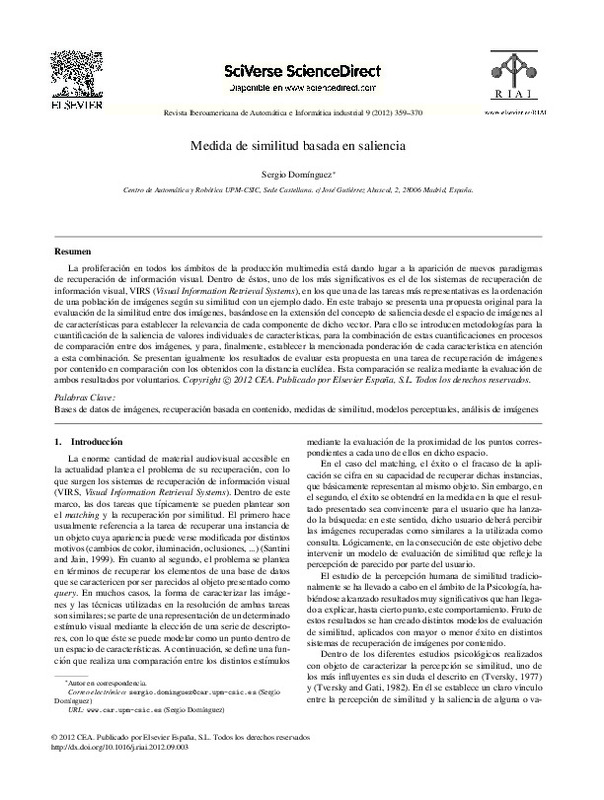Ashby, F. G., & Perrin, N. A. (1988). Toward a unified theory of similarity and recognition. Psychological Review, 95(1), 124-150. doi:10.1037/0033-295x.95.1.124
Chen, G. (2011). Wavelet-based moment invariants for pattern recognition. Optical Engineering, 50(7), 077205. doi:10.1117/1.3597329
Eidenberger, H. (2006). Evaluation and analysis of similarity measures for content-based visual information retrieval. Multimedia Systems, 12(2), 71-87. doi:10.1007/s00530-006-0043-z
[+]
Ashby, F. G., & Perrin, N. A. (1988). Toward a unified theory of similarity and recognition. Psychological Review, 95(1), 124-150. doi:10.1037/0033-295x.95.1.124
Chen, G. (2011). Wavelet-based moment invariants for pattern recognition. Optical Engineering, 50(7), 077205. doi:10.1117/1.3597329
Eidenberger, H. (2006). Evaluation and analysis of similarity measures for content-based visual information retrieval. Multimedia Systems, 12(2), 71-87. doi:10.1007/s00530-006-0043-z
Fairhall, A.L., Lewen, G.D., Bialek, W., de Ryiter van Steveninck, R.R., August 2001. Efficiency and ambiguity in an adaptive neural code. Nature 412 (6849), 787-792.
Fisher, R., 2011. URL: homepages.inf.ed.ac.uk/rbf/CVonline/Imagedbase.htm.
Itti, L., & Baldi, P. (2009). Bayesian surprise attracts human attention. Vision Research, 49(10), 1295-1306. doi:10.1016/j.visres.2008.09.007
Itti, L., Koch, C., March 2001. Computational modelling of visual attention. Nature Reviews Neuroscience 2, 194-203.
Itti, L., Koch, C., Niebur, E., November 1998. A model of saliency-based visual attention for rapid scene analysis. IEEE Transactions on Pattern Analysis and Machine Intelligence 20 (11), 1254-1259.
Kim, Y. S., & Kim, W. Y. (1998). Content-based trademark retrieval system using a visually salient feature. Image and Vision Computing, 16(12-13), 931-939. doi:10.1016/s0262-8856(98)00060-2
Larkey, L. B., & Markman, A. B. (2005). Processes of Similarity Judgment. Cognitive Science, 29(6), 1061-1076. doi:10.1207/s15516709cog0000_30
Rao, R.P. N., Ballard, D.H., January 1999. Predictive coding in the visual cortex: A functional interpretation of some extra-classical receptive-field effects. Nature Neuroscience 2 (1), 79-87.
Santini, S., Jain, R., September 1999. Similarity measures. IEEE Transactions on Pattern Analysis and Machine Intelligence 21 (9), 871-883.
Shepard, R.N., June 1962a. The analysis of proximities: Multidimensional sca- ling with an unknown distance function. i. Psycometrika 27 (2), 125-140.
Shepard, R.N., September 1962b. The analysis of proximities: Multidimen-sional scaling with an unknown distance function.ii. Psycometrika 27 (3), 219-246.
Teh, C.-H., Chin, R.T., !’July 1988. On image analysis by the methods of moments. IEEE Transactions on Pattern Analysis and Machine Intelligen- ce 10 (4), 496-512.
Treue, S. (2003). Visual attention: the where, what, how and why of saliency. Current Opinion in Neurobiology, 13(4), 428-432. doi:10.1016/s0959-4388(03)00105-3
Tsotsos, J. K., Culhane, S. M., Kei Wai, W. Y., Lai, Y., Davis, N., & Nuflo, F. (1995). Modeling visual attention via selective tuning. Artificial Intelligence, 78(1-2), 507-545. doi:10.1016/0004-3702(95)00025-9
Tversky, A., July 1977. Features of similarity. Psychological Review 84 (4), 327-352.
Tversky, A., & Gati, I. (1982). Similarity, separability, and the triangle inequality. Psychological Review, 89(2), 123-154. doi:10.1037/0033-295x.89.2.123
[-]








